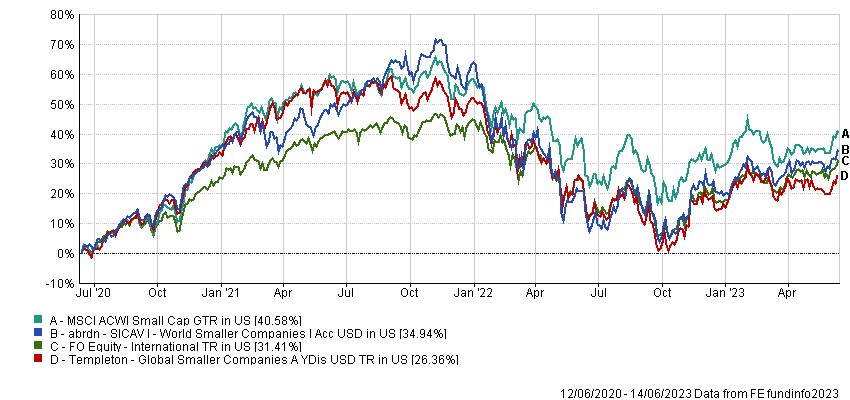
While many believe that now is the time to increase allocations to liquid, large-cap stocks as a potential recession bites, an article from Schroders shows that small-cap companies have historically tended to outperform their large-cap peers.
While bigger companies and conglomerates can generate close to 9% in annualised net total returns during periods of expansion, they only return less than 5% during a recession .
In contrast, small cap companies can provide up to 10% returns when the global economy is in recession.
When comparing the MSCI AC World Index and the MSCI AC World Index Small Cap, both benchmarks generated a three-year cumulative return of over 40% over the last three years, according to FE fundinfo data.
But, coming out of the 2020 coronavirus pandemic, the small-cap index picked up better traction compared with the broader index.
FE Trustnet, an information provider owned by FE fund info, also believes that there is “a larger opportunity set [within small caps] compared to their large-cap peers due to their sheer number and the breadth of sectors that they cover.”
For instance, the Russell 2000 index generated a return of 109% from April 2020 to March 2021 as the global economy was recovering after being hit by the coronavirus pandemic, while the S&P 500 only gained 64% over the same period of time, according to FE fundinfo data.
International fund houses have also taken steps to increasingly find opportunities within the small-cap space.
In Asia, Union Bancaire Privee recently acquired Angel Japan Asset Management, a Tokyo-based independent investment adviser specialised in Japanese small-cap equities.
Against this background, FSA asked Darius McDermott, managing director of Chelsea Financial Services, to select two global small-cap funds for comparison. He chose the abrdn World Smaller Companies fund and the Templeton Global Smaller Companies fund.
| abrdn | Franklin Templeton | |
| Size | $43.8m | $92.5m |
| Inception | 2012 | 1991 |
| Managers | Kirsty Desson | Harlan Hodes, David Tuttle, Katie Ylijoki, Kyle Denning |
| Three-year cumulative return | 30.33% | 21.82% |
| Three-year annualised return | 34.94% | 26.36% |
| Three-year annualised alpha | 0.83 | -2.15 |
| Three-year annualised volatility | 19.58% | 18.88% |
| Three-year information ratio | 0.07 | -0.19 |
| Morningstar star rating | **** | ** |
| Morningstar analyst rating | Neutral | Negative |
| FE Crown fund rating | *** | ** |
| OCF (retail share class) | 1.20% | 1.85% |
Investment approach
The investment philosophy of the abrdn fund is to look for “long-term structural growth drivers”, that is companies with a strong, competitive position.
The market-cap limit of the fund is $5bn at the time of investment, which means the fund has a lower allocation to US equities than many of its peers “to make sure the fund stays true to its small-cap mandate,” said McDermott.
For instance, only 16.5% of the fund’s assets under management are allocated to the US, compared with 41.7% for the Franklin Templeton fund.
The fund adopts a slightly different investment process than other small-cap funds at the company, McDermott noted. Although it uses abrdn’s investing tool, the ‘Matrix’, as a reference to steer idea generation, there is less of a focus on earnings momentum and a heavier skew towards long-term, quality growth.
“Kirsty and the team also target companies with strong or improving returns on equities. Some of these companies almost have a monopolistic structure to their business,” he said.
“The fund is quality growth in nature, but there is some exposure to cyclical stocks (for example it holds shipping names), offering more long-term structural growth opportunities.”
The final portfolio is relatively concentrated at around 50 names and the fund does have some crossover with the abrdn Global Smaller Companies fund, which Desson has managed since February 2020.
“The fund is quality growth in nature, but there is some exposure to cyclical stocks (for example it holds shipping names), offering more long-term structural growth opportunities.”
Darius McDermott, Chelsea Financial Services
On the other hand, the Templeton fund is a more value-oriented product built upon a disciplined, yet flexible, long-term approach.
“Portfolios are structured completely from a stock selection orientation; asset allocation decisions are residual within the process,” McDermott said.
The fund adopts a five-step process, which consists of identifying undervalued stocks, conducting in-depth fundamental analysis, gaining team approval of stocks ideas, constructing portfolios from the team’s approved ‘bargain list’ of stocks and ongoing portfolio and risk monitoring.
Commenting on the fund, Morningstar’s research report noted that it has maintained an overweight to high-yield exposure by holding high dividend-paying stocks and low liquidity exposure compared with its category peers.
In terms of country allocation, both funds invest almost solely in developed markets only, with a bias towards the US and Europe.
The abrdn fund has a higher allocation to Asia, with 8.1% of its AUM invested in Taiwan and 7.8% in Japanese companies, while the Franklin Templeton fund only allocates 6.8% to Japan.
Fund characteristics
Sector allocation:
| abrdn | Franklin Templeton | ||
| Industrials | 28.8% | Consumer Discretionary | 29.0% |
| Information Technology | 24.0% | Industrials | 16.7% |
| Consumer Discretionary | 14.2% | Information Technology | 11.8% |
| Consumer Staples | 10.6% | Financials | 11.4% |
| Health Care | 6.3% | Health Care | 10.9% |
| Financials | 5.3% | Materials | 7.2% |
| Communication Services | 2.8% | Consumer Staples | 5.0% |
| Energy | 2.5% | Energy | 1.9% |
| Other | 0.8% | Real Estate | 1.4% |
| Cash | 4.8% | Cash and Cash Equivalents | 4.75% |
Country allocation:
| abrdn | Franklin Templeton | ||
| United States | 16.5% | United States | 41.7% |
| Taiwan | 8.1% | Italy | 11.7% |
| Japan | 7.8% | Japan | 6.8% |
| United Kingdom | 7.3% | Switzerland | 5.6% |
| France | 7.0% | Taiwan | 5.2% |
| Australia | 7.0% | Germany | 4.2% |
| Sweden | 4.7% | Bahamas | 2.9% |
| Germany | 4.7% | Sweden | 2.6% |
| Other | 32.3% | United Kingdom | 2.5% |
| Cash | 4.8% | Others | 12.1% |
| Cash | 4.8% |
Top 5 holdings:
| abrdn | Weighting | Franklin Templeton | Weighting |
| Interparfums | 4.7% | Onespaworld | 2.9% |
| Dino Polska | 4.6% | Asics | 2.9% |
| Brunello Cuicinelli | 4.4% | Brunello Cucinelli Spa | 2.8% |
| Asics | 4.1% | Alamo | 2.8% |
| Axon Enterprise | 4.0% | Columbia Sportswear | 2.5% |
Performance
Although both funds have generated double-digit returns over the past three years, according to FE fundinfo, there is quite a significant difference in performance when compared with the benchmark.
The abrdn fund returned 35% over the three-year period, while the Templeton fund posted a return of 26% compared with the MSCI ACWI Small Cap index average of 41% and the FE fundinfo international equity sector average of 31%.
The recovery trajectory for both funds after the 2020 coronavirus outbreak was pretty similar and on par with both the sector average and index average.
The Templeton fund then started to outperform its abrdn peer in the first quarter of 2021, but the abrdn fund played catch up to reverse the performance in the second half of the year.
“As the above indicates, the abrdn fund has a quality growth focus, while the Templeton fund should thrive more in a value-led market,” said McDermott.

When the small-cap market was generating a positive return over the past five years, the abrdn fund outperformed the index and the Templeton fund by a large margin.
However, in 2022, the fund underperformed the sector by falling 26% as value companies led the market.
On the other hand, the Templeton fund returned slightly below the index average in 2020 and 2021 with a return of about 14% for both years and fell 24% in 2022.
“Part of this fall can be attributed to the challenges faced by small caps in general last year, with inflation and rate rises putting smaller business enterprises under significant pressure,” McDermott said.
Nevertheless, both funds have produced positive returns year-to-date and have outperformed the index average.
Discrete calendar year performance
| Fund/Sector | YTD* | 2022 | 2021 | 2020 | 2019 | 2018 |
| abrdn | 11.7% | -26.3% | 20.7% | 26.7% | 30.0% | -8.9% |
| Franklin Templeton | 9.6% | -24.0% | 13.5% | 13.6% | 20.89% | -19.2% |
| MSCI ACWI Small Cap | 8.8% | -18.3% | 14.5% | 16.8% | 25.2% | -14.0% |
Manager review
The two funds have a distinctly different management structure. While abrdn’s fund is only led by one manager, Kristy Desson, the Templeton fund is overseen by four managers.
Desson has been in charge of the product for less than two years, but her career began in 2000 at Martin Currie, where she analysed companies in Asia and emerging markets.
She joined the fund house in 2012, with a focus on smaller companies within Asia, including Japan and emerging markets.
Apart from the World Smaller Companies fund, Desson has also run the Global Smaller Companies fund since February 2020.
On the other hand, the Templeton fund is jointly managed by four people: Harlan Hodes, David Tuttle, Katie Ylijoki and Kyle Denning.
“The Templeton global equity group is comprised of experienced portfolio managers/analysts located around the world,” said McDermott.
Harlan Hodes is the executive vice president and director of small-cap research for the Templeton global equity group.
He joined the firm in 2001 and also manages other small-cap institutional portfolios, including the Templeton International Smaller Companies fund and the TIF Foreign Smaller Companies fund.
Tuttle, who joined the company in 2002, is a vice president, portfolio manager and research analyst for the Templeton global equity group, with research coverage of global small-cap energy, materials and financials, as well as Canadian financials for the large-cap team.
Kyle Denning and Katie Ylijoki joined as co-managers in 2022.
Conclusion
Based on historical returns, Morningstar rates the Franklin Templeton fund two stars, while the abrdn fund received four stars.
Meanwhile, abrdn received a neutral analyst rating, while the Franklin Templeton fund has a negative rating.
When commenting on the Templeton fund, the Morningstar manager research team believes the product’s “lofty” fees and lower-than average manager retention rate has dragged down its performance.
FE Fundinfo, which bases its assessment on a fund’s three-year history of delivering alpha, minimising relative volatility and producing consistent returns, also ranked the abrdn fund higher with three crowns and gives the Templeton fund two crowns.
“There is an argument to suggest these funds would complement each other in terms of one being a quality, growth-led vehicle and another more geared towards value-driven investing,” McDermott commented.
Yet, when it comes to choosing between the two, he said he would lean towards abrdn despite its performance last year.
“This fund is slightly different to what the small-cap team typically offers, but it does employ a number of processes used across the rest of the desk as a guide,” he said.
“We also like the core nature of the fund (it can have some cyclical names despite a greater focus on quality growth).”
He is also confident that the fund manager, Desson, is a safe pair of hands, having worked on a number of other small-cap portfolios over the years.

















